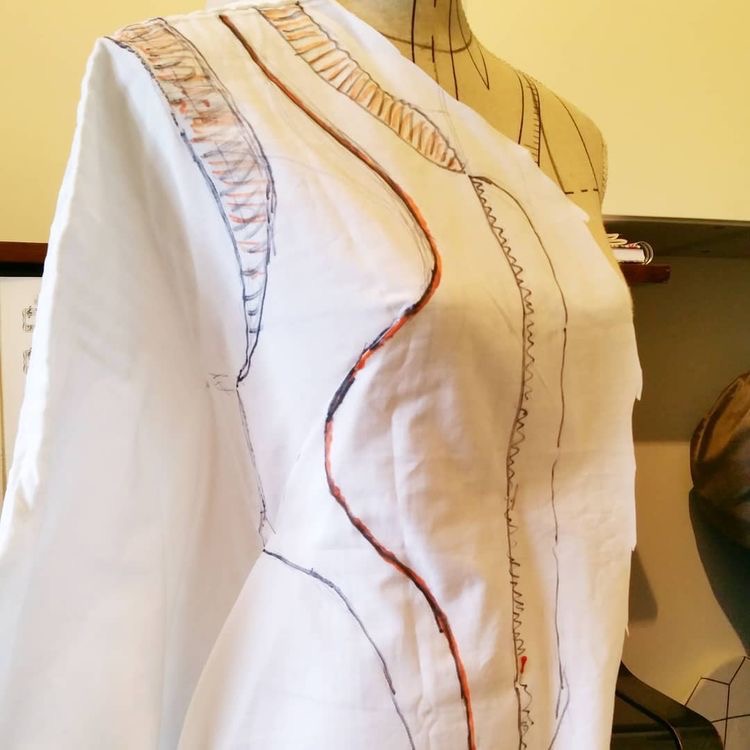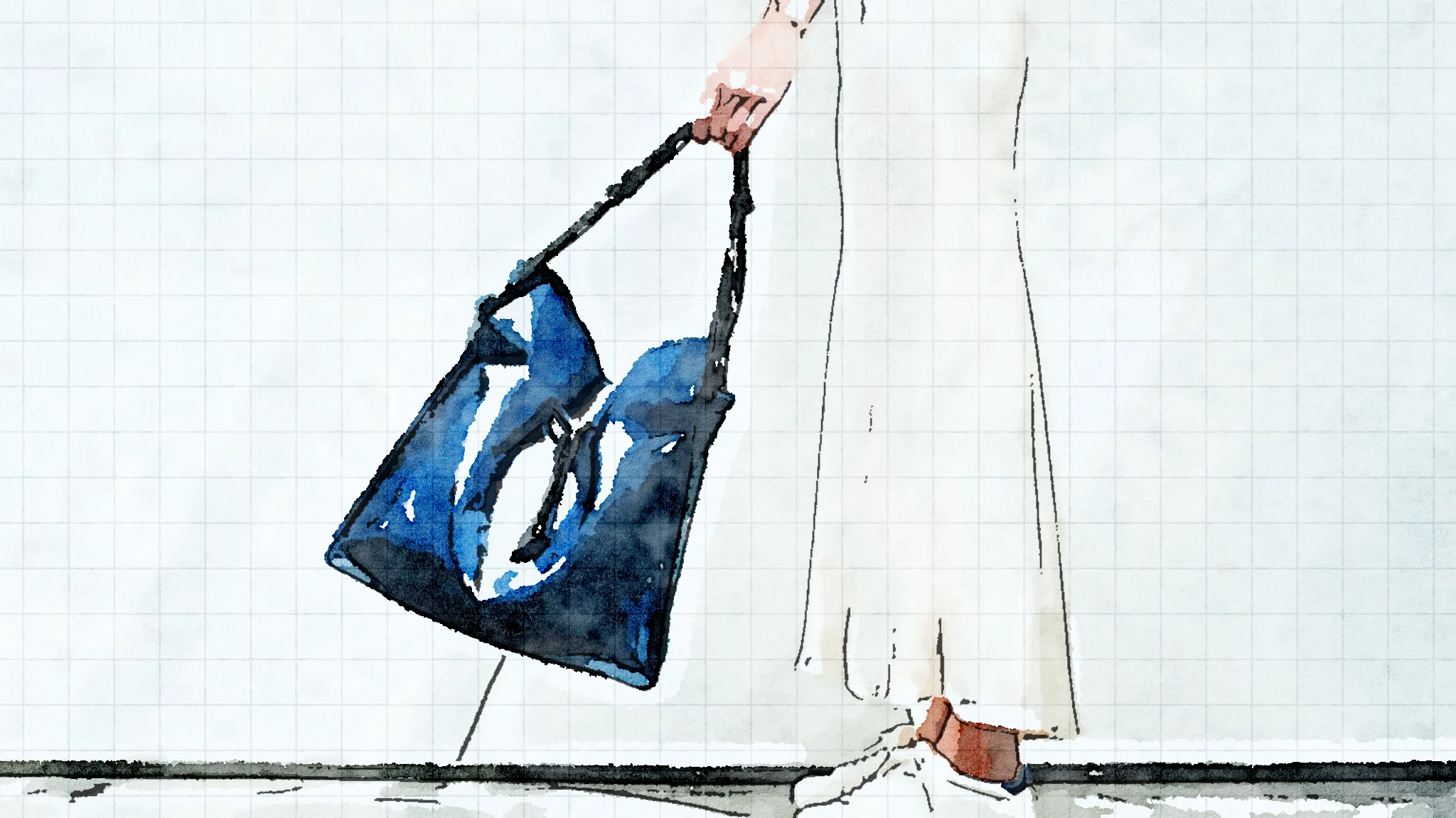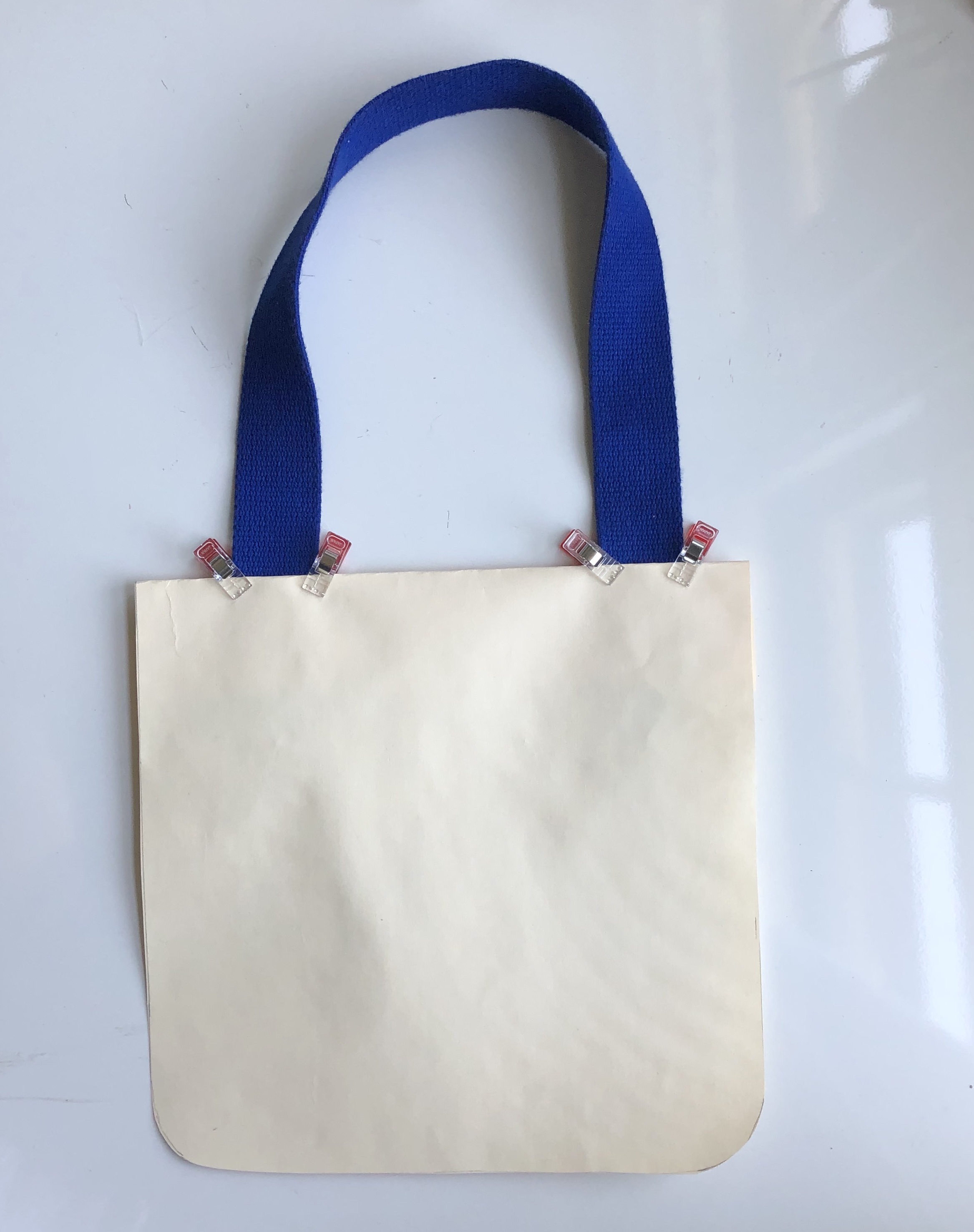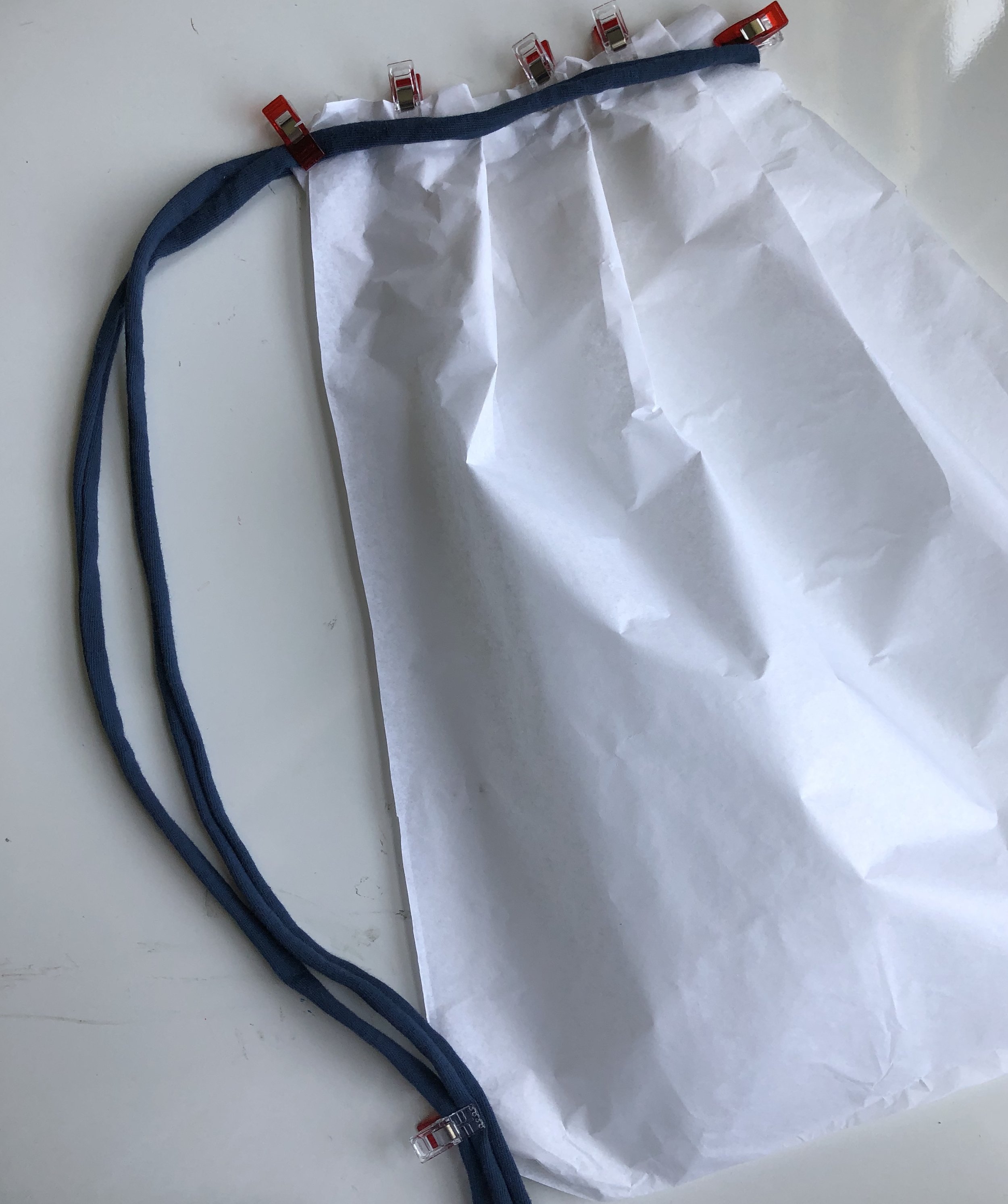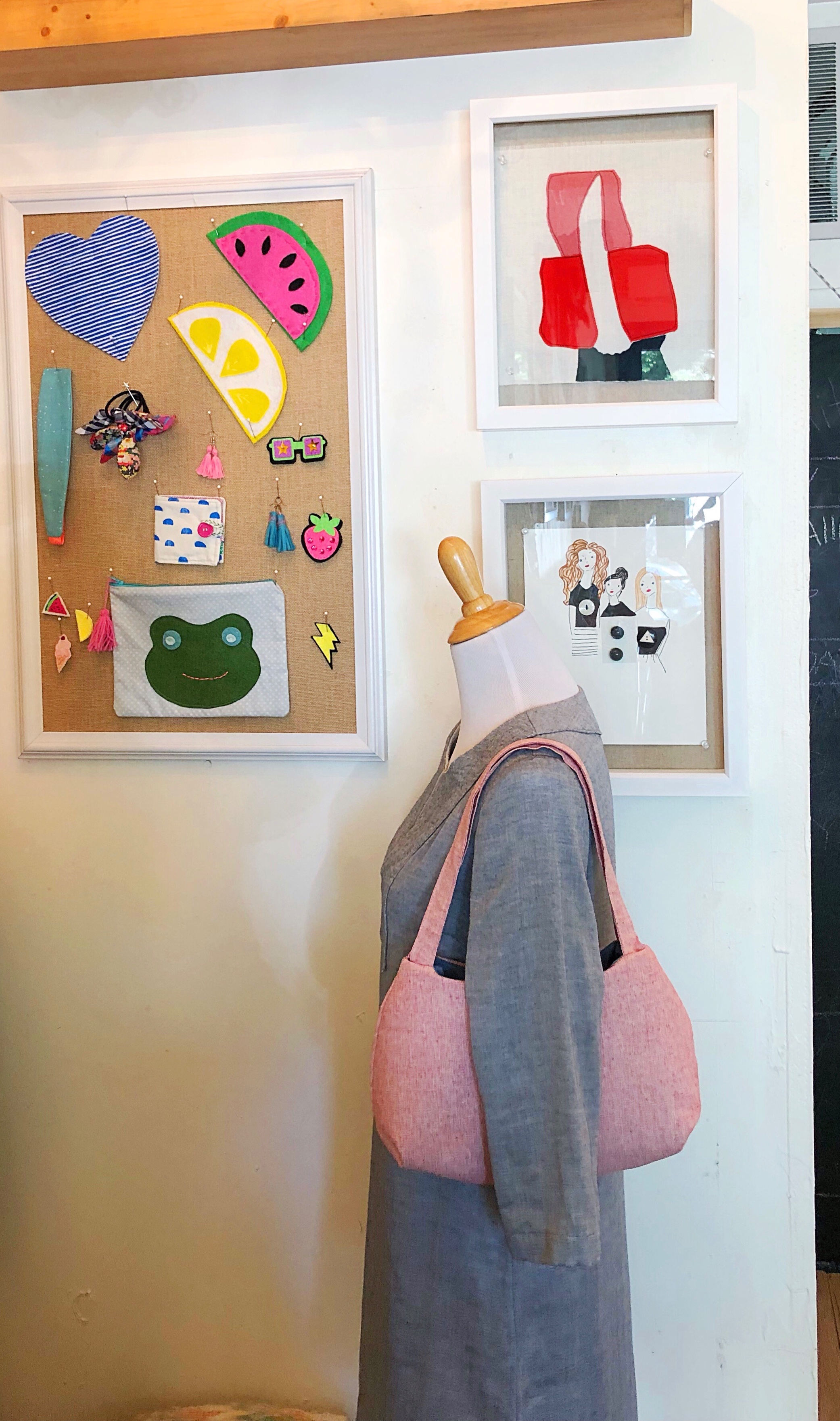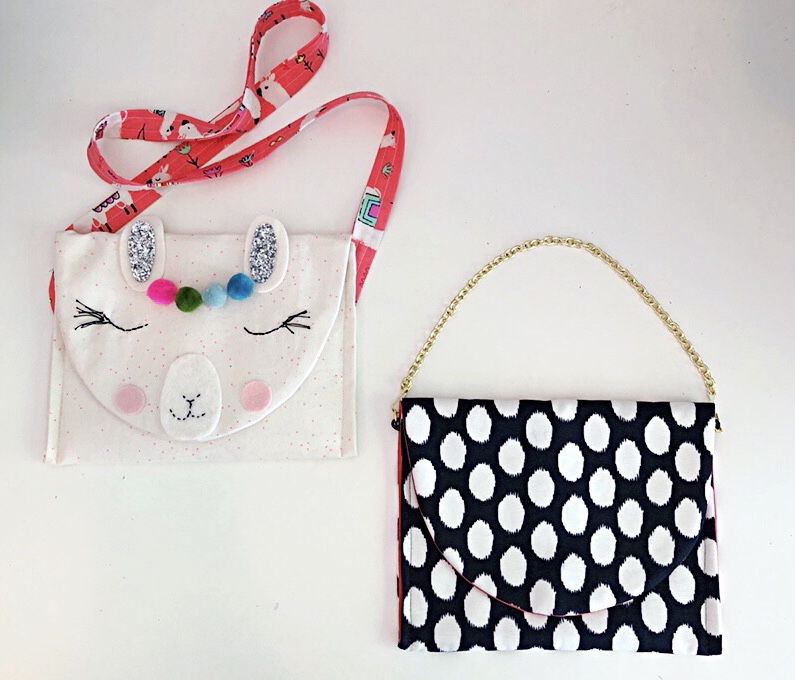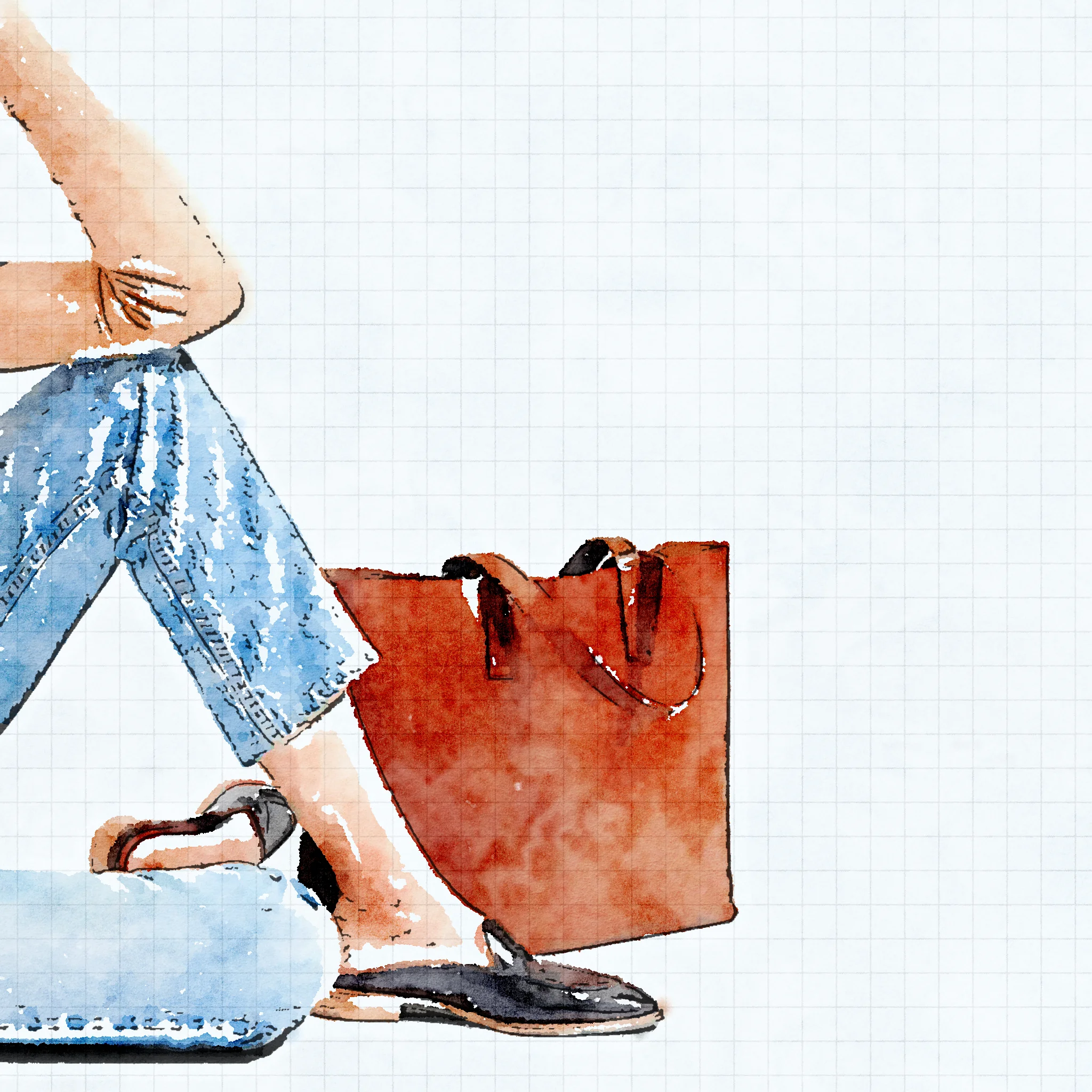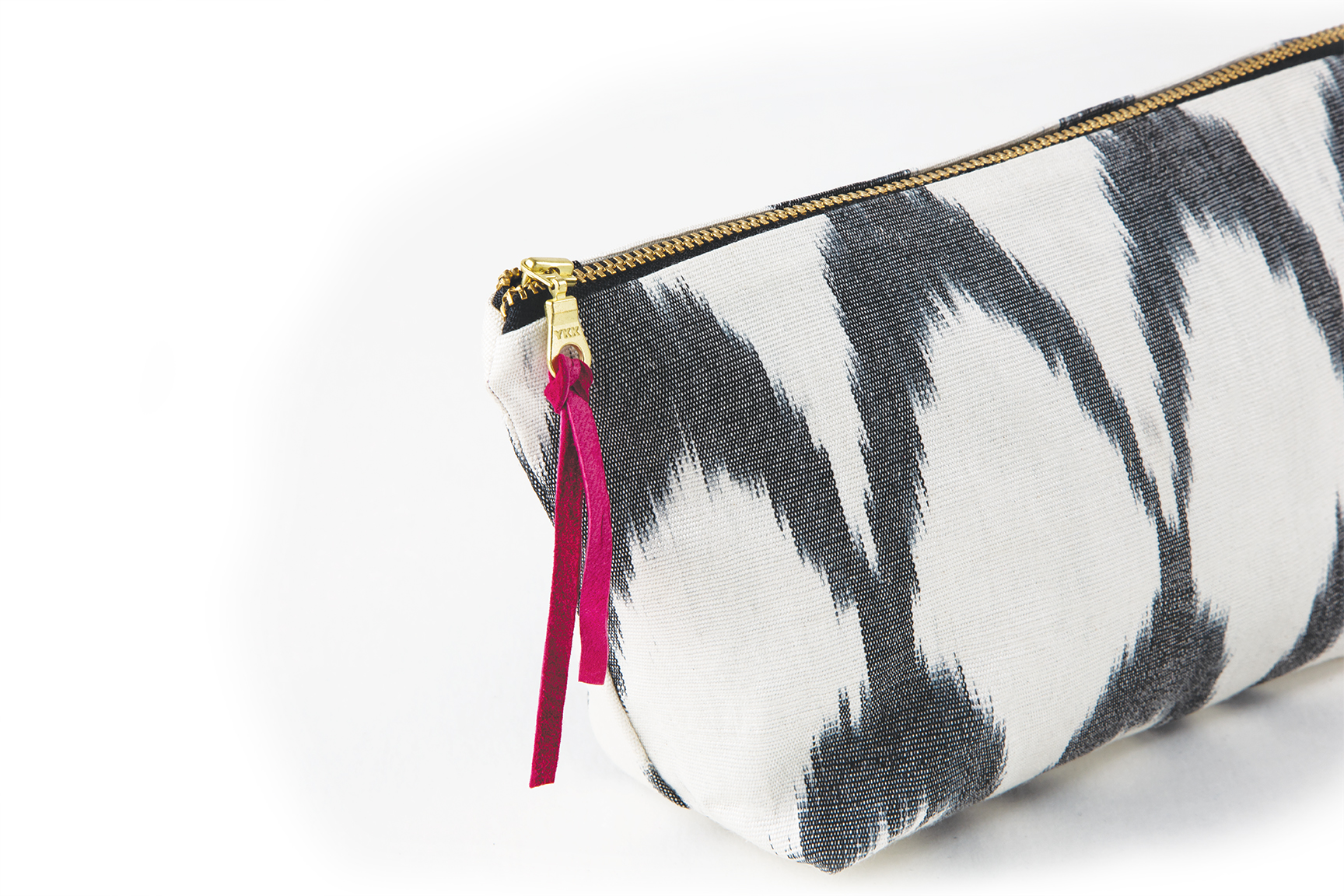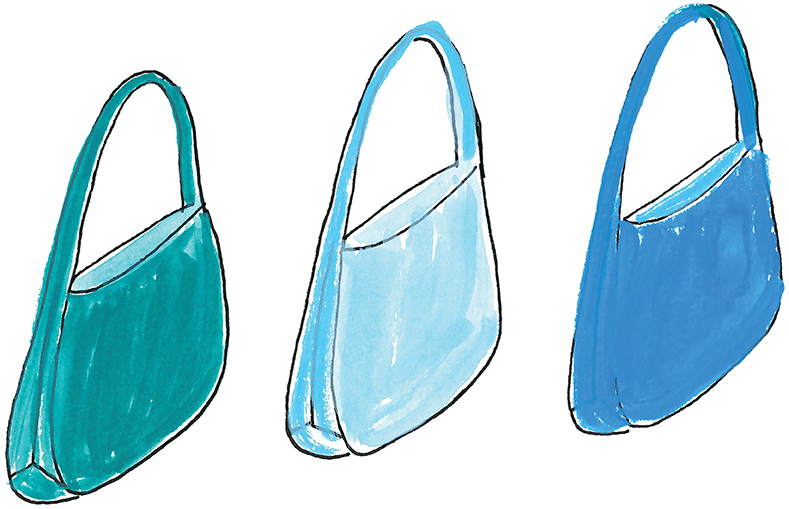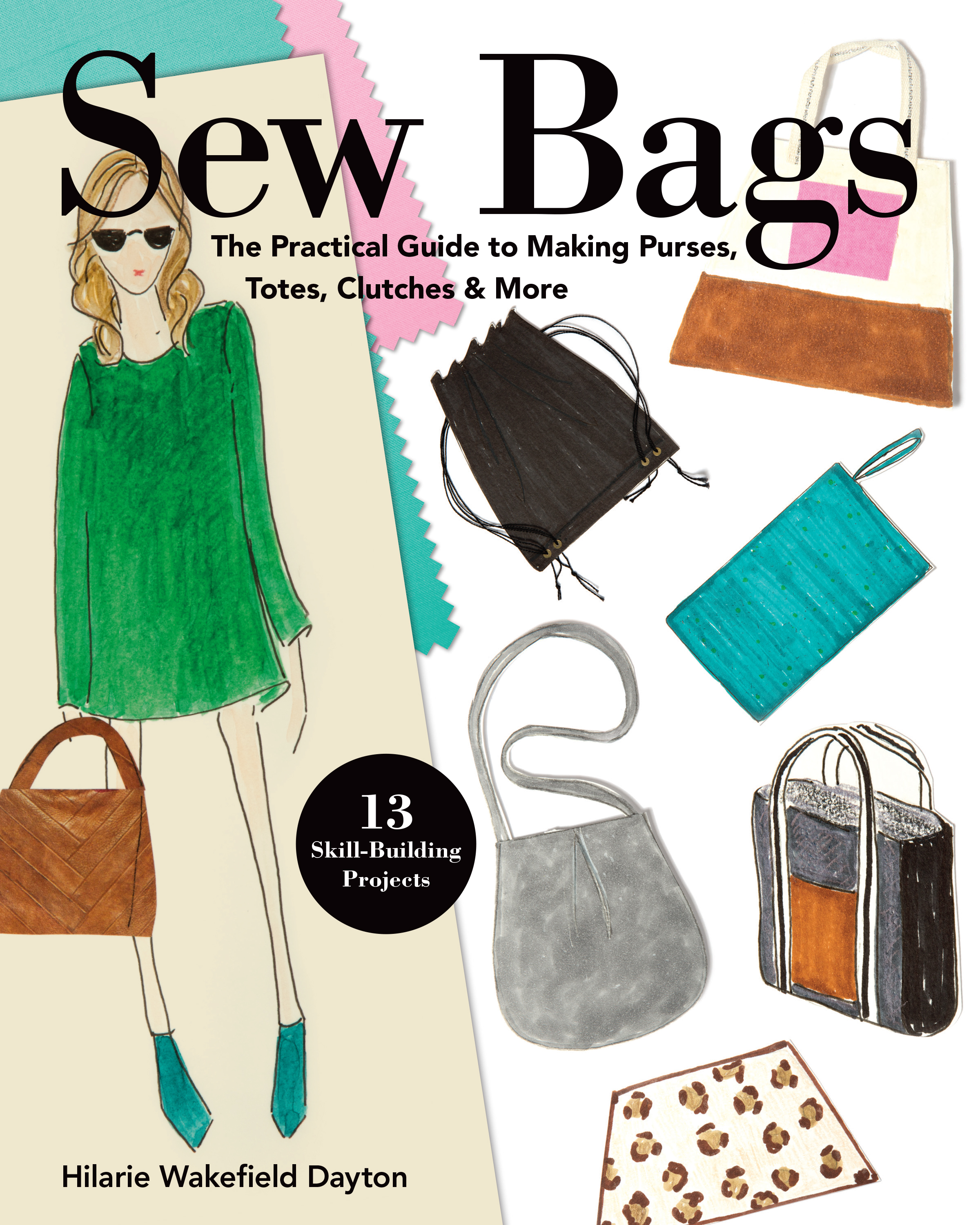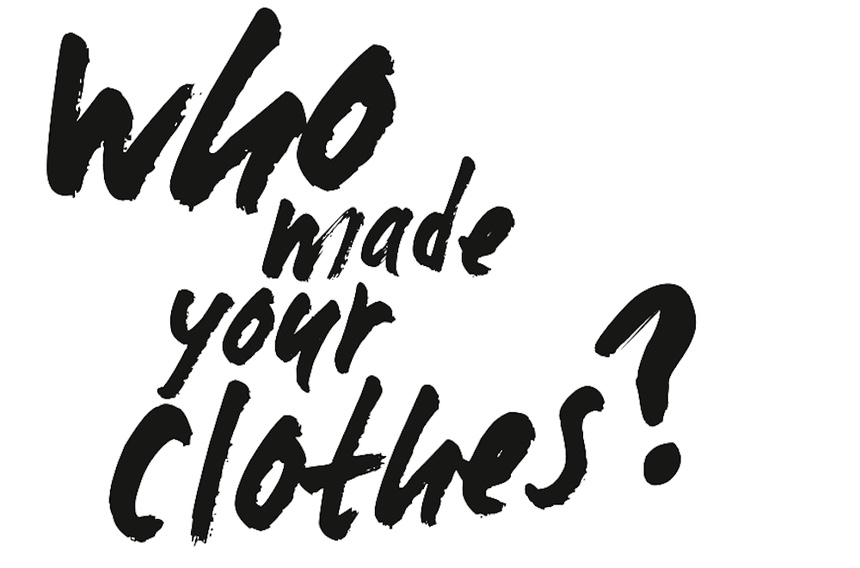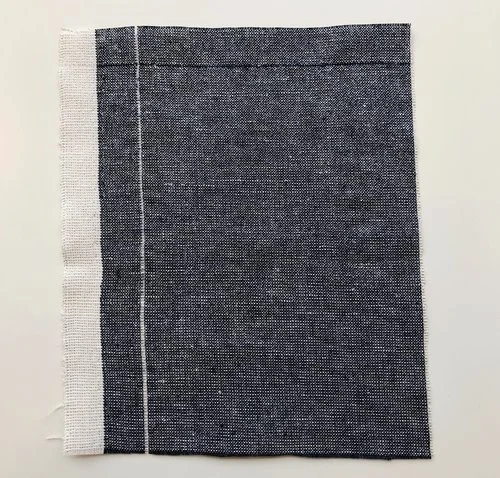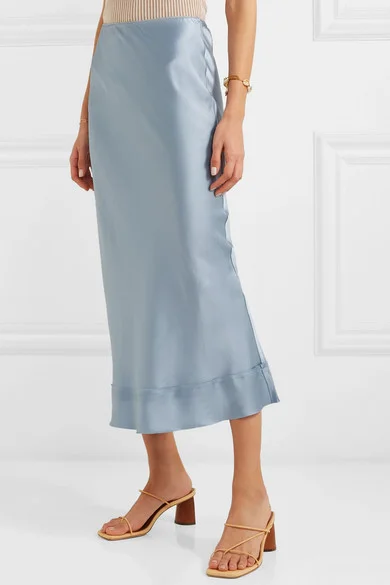Sew Bags; The Blog Tour Re-cap
I teach sewing and design because I believe that everyone possesses some innate creative ability and once you tap into that and discover your passion, it can build confidence that flows into all aspects of life.
These past few weeks, I have had to take a deep dive into my confidence reserve.
As the publication of my book drew near, I knew that it was time to begin to organize a promotional book blog tour. In order for the book to sell, people have to know about it - right? By May, sheer panic set in. Besides the fact that I am terribly introverted and likely would never own a phone, let alone leave the house given the chance, I had to ask complete strangers to read my book and to (PLEASE!) make something from it and share it with the world.
I teach sewing and design because I believe that everyone possesses some innate creative ability and once you tap into that and discover your passion, it can build confidence that flows into all aspects of life.
These past few weeks, I have had to take a deep dive into my own confidence reserve.
As the publication of my book drew near, I knew that it was time to begin to organize a promotional book blog tour. In order for the book to sell, people have to know about it - right? By May, sheer panic set in. Besides the fact that I am terribly introverted and likely would never own a phone, let alone leave the house given the chance, I had to ask complete strangers to read my book and to (PLEASE!) make something from it and share it with the world.
At first, I thought, who am I going to ask? Fabric companies? maybe. Celebrities? nah. Some sewing blogging superstars with comanding audiences? (well…..) Then I began to scroll through my Instagram feed and consider who’s posts I always look forward to reading. Who seems approachable enough to ask? Who would even recognize my name if I did message them? Finally- who has a similar philophsy to teaching and style and would “get” my message. Well- that certainly narrowed down the possibilities considerably. Since I teach sewing, who better to ask then other fashion-forward sewing teachers too.
As it turns out, sewing teachers might just be among the nicest and most approachable people ever! Each of the following women are incredibly busy with a business, projects and families of their own. I owe them a huge thank you for the kindness that they have shown me by generously sharing their time and talents. I hope that each of you will read their posts and draw inspiration from their interpretation of my bag patterns.
Jesy, Needle, Ink and Thread
In a conversation with a friend who is also a sewing teacher, she asked me if I know Jesy. I answered that I didn’t. She told me to check out her work and mentioned that she is exceptionally talented and super nice! As it turns out, besides teaching sewing, Jesy was a former co-owner of Sew Dayton, has contributed a project to a new book as well as sewing custom projects and alterations. If she can pull that off, maybe a small bag wouldn’t be too much to ask:) Jesy agreed and was in!
Jesy made the Bunny Backpack from Sew Bags.
Adorable, right? I love her smile.
Jesy’s Tooth Fairy Pillow project is featured in this book, 50 Little Gifts.
Julia, Old Spool Sewing
Several months ago while looking through Instagram, a friendly smiling face appeared in my feed. I clicked on her post and woah! Another fun sewing studio for kids. Her studio looked bright and filled with lots of smiling kids. Then I saw this cute, cute red wrap top. Well, I do love a wrap top so I commented. She wrote back and then BAMN! #insta-friends:) As it turns out, Julia went to Parson’s and has a degree in Fashion Design which she now uses in her efforts to inspire and cultivate creative talent. So…. I asked Julia too- And she said yes!
Julia made the Abigail Boxed- Bottom tote - complete with hand dyed shibori!
The red wrap-top
Julia was a contestant on Slice TV’s Stitched.
Katie of Katie Kortman
Last summer I saw on Facebook that a new sewing and art studio for kids had opened in a neighboring city. Intrigued, I clicked to find out more. It turns out, Katie had moved in like the week before. I guess as a military mom of 4, she was well practiced in the art of moving and managing kids and projects. I reached out to introduce myself and see if she was taking on new students as I was maxed out at the time and know that families would be thrilled to hear that there was another place to send their kids. This was before Katie blew up Instgram with her hashtag game and spinning color wheel of fun. So- is it safe to say I “knew” Katie before she was famous?? Somehow she fit my project in with everything else she is juggling. Hello- new Spoonflower collection!!
Katie’s handprinted suede Savannah Cross-body bag.
Katie’s fabric collection with Spoonflower.
More fabric and color inspiration!
Tree, Stitchless TV
A few years ago during Makers for Fashion Revolution, #makersforfashrev, I discovered both Tree of Stitchless TV and Kate of Sewing with Kate. Tree had posted a picture of a bathing suit that she had made with a custom printed fabric. I commented that years ago, I worked with a swimwear designer and had made many, many suits over the years. She immediately wrote back and we have followed each other’s feed since. While we have never met in person, I do feel a strong creative connection with Tree. She is absolutely fearless in her approach to both teaching and sewing. And, as many of you know, I loathe TV and YouTube but make a special point of sharing her videos and tutorials with my students. They are that good!
One thing that Tree always emphasizes is her belief that with a bit of experience, anyone can learn to design a bag or garment and experience the absolute thrill of using and wearing something that you made yourself.
When you see something like this, it is an immediate signifier that the person both knows what they are doing and is fearless in her approach.
How beautiful is this coat that the wearer made in one of Tree’s workshops?
Ribbon embroidery on mohair. Seriously.
Kate, Sewing with Kate
Kate had me at first glance of her Sashiko. Anyone who spends that much time sewing by hand is someone who really understands the importance of attention to detail. Hand sewing allows a much finer degree of control over the fabric and fit, compared with using a machine. Kate understands that. Also- perhaps since she is a mom of a bunch of kids, hand sewing is portable and thus, gets done and is a great way to keep your hands busy while endless waiting for kid sports and activities.
After gushing over her sashiko samplers and bags (she has an etsy shop with patterns too! ) I then saw her clothes. That was it- I was a fan for life. Come on now, how freaking fantastic are these next two dresses? The embellishment and that leather. So I had to ask….would you make one of my bags?
Kate made the Rachel Drawstring Pouch- and hand stitched the sashiko pattern before sewing the bag.
This proves that there is nothing better than a well- fitting garment with one stand out feature.
Leather shoulder inset of my dreams.
I just love how each of these ladies took the original pattern and spun it to create something that is unique to their style. That is my ultimate goal as a pattern maker, sewing teacher and now author. To impart the lesson that you don’t have to just follow the pattern; treat the suggestions in your pattern as starting points and use your own imagination and skills to make the bag that suits you.
Happy Sewing!
XOXO, Hilarie
Please remember to tag me on social media with your makes using the hashtag #sewbags. I can’t wait to see what you share.
Understanding Purse Straps and Handles
I am so thrilled that my blog tour week is finally here! My new book: Sew Bags: The Practical Guide to Making Purses, Totes, Clutches & More; 13 Skill-Building Projects is written as a guide, complete with patterns and step by step instructions ,to help you create the bag of your dreams. This week, a few gracious sewing friends from across the globe are generously giving us their time and sharing their thoughts and projects from my book. I just can’t wait to see what they have made.
After a lovely introduction from my friends at C&T yesterday, I thought that I would follow up today by sharing my thoughts on creating a bag that suits you as the wearer. A purse is an opportunity to show the world your personal style and the silhouette that best represents you. Which means: any old bag just won’t do. Like it or not, your purse says a lot about you. Are you a mom that has to carry everything for everyone? Are you a just the basics and cut it to the essentials? Are you out for friends with the night and carrying a fun clutch? Besides toting the essentials, a purse is also an accessory-a blank canvases that can project your mood, your favorite trend, or your aesthetic of the moment.
Since everyone is different, there are also adjustments you can make to a sewing pattern that will customize the bag perfectly to your body and individual needs to ensure that your bag is useful as well as beautiful. I’m all about customization and straps and handles are a great way to both customize and accessorize.
I am so thrilled that my blog tour week is finally here! My new book: Sew Bags: The Practical Guide to Making Purses, Totes, Clutches & More; 13 Skill-Building Projects is written as a guide, complete with patterns and step by step instructions ,to help you create the bag of your dreams. This week, a few gracious sewing friends from across the globe are generously giving us their time and sharing their thoughts and projects from my book. I just can’t wait to see what they have made.
I hope that you follow along to check out their take on the projects and enter to win a copy of Sew Bags at each stop! You can enter the C&T giveaway HERE.
Tuesday, 7/1: C&T Publishing
Wednesday, 7/2: Hilarie Wakefield Dayton of Little Stitch Studio Norfolk
Thursday, 7/3: Katie Kortman
Julia of Old Spool Sewing
Friday, 7/4: Jessy of Needle, Ink and Thread
StitchlessTV (YouTube video)
Monday, 7/8: Sewing with Kate
This week on Instagram, look for TopStitch Atlantas Instagram story .
After a lovely introduction from my friends at C&T yesterday, I thought that I would follow up today by sharing my thoughts on creating a bag that suits you as the wearer. A purse is an opportunity to show the world your personal style and the silhouette that best represents you. Which means: any old bag just won’t do. Like it or not, your purse says a lot about you. Are you a mom that has to carry everything for everyone? Are you a just the basics and cut it to the essentials? Are you out for friends with the night and carrying a fun clutch? Besides toting the essentials, a purse is also an accessory-a blank canvases that can project your mood, your favorite trend, or your aesthetic of the moment.
Since everyone is different, there are also adjustments you can make to a sewing pattern that will customize the bag perfectly to your body and individual needs to ensure that your bag is useful as well as beautiful. I’m all about customization and straps and handles are a great way to both customize and accessorize.
STRAPS AND HANDLES
Bag straps and handles are so much more than a mere function of convenience. They are exciting design features on their own. Not to mention, major considerations in determining the usefulness of any given bag.
We all have fallen in love with a bag that had handles that just weren’t right: Too thin and they cut into your arm or shoulder or too wide and they slide off. It is important to consider how you will carry your bag as well as what it can fit. Do you wear it on your shoulder? Over a coat? On the crook of your arm? In your hand? Keep in mind that smaller bags use thinner straps and larger bags use wider straps.
The most challenging part of sewing a bag is that you can't try it on until after it’s finished. And, if it doesn't fit right, you can't just exchange it for another size. Finding the right fit before you start sewing can solve this problem. I suggest that before you make any bag, stop and consider the strap length before cutting into your fabric. This is such an easy way to begin to customize the pattern and make the finished bag comfortable and fit you.
The Heidi Side Panel tote from my book, Sew Bags: The Practical Guide to Making Purses, Totes, Clutches and More, in two ways. The first, with leather straps set with rivets and extra handy D-ring detail, the second with cotton webbing strap detail and leather front patch pocket.
Strap Length and Drop
There are a couple of ways to determine the overall size and fit of a bag before you begin. One way is to measure a bag that you already own and know it fits just the way you like. (This is also a great trick when making someone else a bag as a surprise. You can simply borrow their bag for minute and take a quick measurement.) The second way is to make a paper mock-up of your bag and using a ribbon and clips or pins, play with the straps length and width until you find the one that is the most flattering and comfortable. Then measure that ribbon from end to end to determine the length. Write that number down- because it may need to be adjusted depending on the strap placement on the bag, the hardware used and what material the strap is made out of.
A tote mock-up made of oaktag. Handles are clipped to the top to test for fit.
In this drawstring backpack mock-up, I used tissue paper so that it would better hold a “cinched effect”. The cord is wrapped around the cinched opening and pulled to the bottom. Once I was happy with the way that it fit, I measured the cord and recorded that as my strap length.
Dress forms playing dress-up with the bags.
This is a good time to refer to the bag pattern. Where is the strap placed? It is aligned at the top of the bag or a few inches down, if you are making out of fabric, you’ll need to account for the seam allowance. Would you prefer the added polish and flexibility of a D-ring? If so, then you will need to consider the diameter of the ring to the overall length.
Here is a handy guide to use as a general rule of thumb in determining the appropriate strap length for each style of bag. Remember- this is just for reference, make the length that suits you.
1. Wristlet (6 to 10 inches)
2. Short Handle (12 to 20 inches)
3. Shoulder (30 inches)
4. Long Shoulder (40 inches)
5. Crossbody (50 inches)
6. Extra Long (60 inches)
7. Adjustable (22 to 60 inches)
Drop Length
After you determine the optimal length for your strap, we need to talk about the drop length. Drop length is defined as the distance between the top of the bag and the top of the handles.
The Wesley Shoulder Bag from my book, Sew Bags: The Practical Guide to Making Purses, Totes, Clutches and More. Compare the drop of the bag to the length of the arm. Would that be comfortable for you to carry?
How do you like to wear your bag? Some people like their tote to sit close to their body, while others want a little more room. Thinking about which one you'd prefer can help you decide on the perfect drop length. Choosing a longer drop length can make a big difference in giving you more space to maneuver. (Like when you are standing at the door holding onto a kid and reaching into the bag that is on your shoulder and trying not to break your wrist.)
If you're unsure about the right length, the easiest way to get an idea of which drop length would work best for you is again, measuring a bag that you already own and find comfortable to carry. Even if your current bag is a little snug for your taste, measuring the drop length of the handles can still give you an idea of what would work best for you.
The drop length of a bag strap may be altered by an adjustable slide. *blog post coming soon!
Fabric and Materials
Once you have the length, width and drop determined- now it is time to consider what fabric or material you are going to make your straps or handles out of. Lately designers are shedding a new light on handles as the primary design feature of a handbag. Take cotton webbing for example. It is the new design detail that’s been featured on bags of every price point. Inspired by the logo-mania trend of recent seasons, these woven wonders are giving our everyday bags a whole new lease on life, lending them a high-fashion feel. But the excitement doesn’t end there. You can also make the strap with a chain, leather (genuine or imitation), Kraft-tex, fabric or any combination of the bunch.
A recent visit to JoAnn’s Fabric confirmed the webbing strap trend!
See how a strap can change the entire look and function of a bag? This bag is the Morganne bag in my book. Made in quilting cotton with a contrast cross-body strap, it is the perfect bag for a child. In silk with a gold chain, you are ready to go out on the town.
Straps are such a fun way to introduce an individual approach to a handbag, distinguishing it as its own distinctive piece. I am so excited to see the bags that you are going to make. Please use the hashtag #sewbags on social media- and be sure to tag me @littlestitchstudio.
In my next post, I am going to explore some essential bag making hardware: swivel hooks, slide adjusters, and rings.
XO, Hilarie
One Size Does Not Fit All
The ultimate expression of my obsession with customization, begins with a beautiful, simple everyday bag. Each bag in my book, Sew Bags: The Practical Guide to Making Purses, Totes, Clutches & More was designed with this in mind. The clean lines and thoughtful details invite you, the reader, to be the designer. While you can certainly make a bag exactly as the pattern directs, if you can manage a little extra time, in addition to a small stroke of creativity, the ability to make handbags totally your own could be a serious game changer.
The fun begins when you start to break the design down to the component parts. Fabric, hardware, handles, straps and decorative accessories can be mixed and matched to create a bag that’s uniquely yours.
The ultimate expression of my obsession with customization, begins with a beautiful, simple everyday bag. Each bag in my book, Sew Bags: The Practical Guide to Making Purses, Totes, Clutches & More was designed with this in mind. The clean lines and thoughtful details invite you, the reader, to be the designer. While you can certainly make a bag exactly as the pattern directs, if you can manage a little extra time, in addition to a small stroke of creativity, the ability to make handbags totally your own could be a serious game changer.
The fun begins when you start to break the design down to the component parts. Fabric, hardware, handles, straps and decorative accessories can be mixed and matched to create a bag that’s uniquely yours.
Perfect design is a matter of personal expression and preference. What would your dream handbag look like? For me, it is almost always some kind of tote-style bag. I carry a lot of stuff around and need a sturdy bag that looks great but is also comfortable to carry and functional. Often times though when I see a great bag that I love, it is missing some essential requirement. More often than not, it doesn’t have enough pockets or the strap length is just not right. Since my overall goal is to encourage you to be a part of the design process, I intentionally left out interior pockets in the bags. This allows you, as the designer to make those decisions yourself.
I encourage you as you work through a pattern to consider the overall size and function of the project as well as the fabric and color. (Being involved in the design process can be just as fulfilling as actually cutting and sewing your bag.) To that end, you can look forward to future posts that will help to enrich your experience. First up- Straps and Handles.
XO, Hilarie
Sew Bags- Behind the Scenes (Seams!)
I love, love, love hearing from all of you that have purchased my book, Sew Bags! Thank you! It makes me so very happy to hear how much you are enjoying it. This has been such a meaningful project for me to work on and I could not have done it without the help and dedication of so many talented individuals such as my publisher, Stash Books, an imprint of C&T, Kelly Burgoyne, an amazing photographer, April Mostek, book designer, editors Liz Aneloski, Debbie Rodgers and Beth Baumgartel, and Acquisitions Editor Roxane Cerda. And of course to all of you!! My readers and students who really make all that I do so meaningful.
As for the book itself, where do I start? When I set out to write the book over two years ago, I had a vision of what it might be like, both the experience of writing and what the final book would be like. While the book is so much better than I had envisioned, the actual writing process was really very difficult for me. It took me much longer to prepare each step and thoughtfully communicate clearly yet concisely what I wanted the reader to learn. (I have trouble with distraction on a good day- this project required a few overnight hotel stays and a level of concentration that I was no longer familiar with.) Teaching has kept me grounded in the beginner’s experience. The projects that they are interested in making, the questions that they ask and the troubles that they encounter along the way. I wanted to be certain that each project and step would build confidence instead of frustration. What a valuable experience this was for me! I know that since writing this book, I have become a better teacher.
I love, love, love hearing from all of you that have purchased my book, Sew Bags! Thank you! It makes me so very happy to hear how much you are enjoying it. This has been such a meaningful project for me to work on and I could not have done it without the help and dedication of so many talented individuals such as my publisher, Stash Books, an imprint of C&T Publishing, Kelly Burgoyne, an amazing photographer, April Mostek, book designer, editors Liz Aneloski, Debbie Rodgers and Beth Baumgartel, and, Acquisitions Editor Roxane Cerda. And of course to all of you!! My readers and students who really make all that I do so meaningful.
As for the book itself, where do I start? When I set out to write the book over two years ago, I had a vision of what it might be like, both the experience of writing and what the final book would be like. While the book is so much better than I had envisioned, the actual writing process was really very difficult for me. It took me much longer to prepare each step and thoughtfully communicate clearly yet concisely what I wanted the reader to learn. (I have trouble with distraction on a good day- this project required a few overnight hotel stays and a level of concentration that I was no longer familiar with.) Teaching has kept me grounded in the beginner’s experience. The projects that they are interested in making, the questions that they ask and the troubles that they encounter along the way. I wanted to be certain that each project and step would build confidence instead of frustration. What a valuable experience this was for me! I know that since writing this book, I have become a better teacher.
Hotel Room, night one. Lots of coffee, zero sleep.
Inspiration for the color wheel art finally struck! This is actually one of my very favorite pieces hanging in the shop and one that lots of my students always ask to make. Guess what? The upcoming campers in next month’s Art of Design Camp get to make this project.
The book is about making bags, of course. But really, the lessons are based on classic sewing techniques. Master these skills, and they will forever be part of your repertoire. My goal is to teach you how to sew in such a way that it is not so much about the specific project, but more about the how’s and why’s of each skill. Once you have a basic understanding of construction, the logic of each project becomes considerably clearer.
Since the projects are bags, they had to be fantastic looking! So many sewing books that I see that are about bag making are either too “crafty looking” or very intensive and require a level of skill, time and supplies that many of my students don’t have. I wanted my book to be different. Part aspirational but definitely attainable. I want it to attract someone with little skill and for them to be excited to make and carry or someone who already knows how to sew, but doesn’t want to spend weeks working on a bag. For this, the bags needed to be simple in design but look like something I would (do!) actually carry.
The projects are grouped into four categories: shoulder-strap bags, tote bags, zipper clutches, and drawstring bags. The first bag sets the skill, and the rest build on that. You will master techniques such as making straps, pleats, boxing the bottom of a bag (to create a base), making pockets, applying bias tape, and installing zippers.
Each project has step by step photos and written instructions. Plus some illustrations! I was so thrilled and flat out stunned during the book writing process when my editor asked if I would considering sharing more of my illustrations. Never did I imagine that they would be on the cover! You will find lots of illustrations throughout the book too. In fact, one of my favorite book details is how they cropped tiny bits a color exercise from the sketch book that I sent in and use them throughout the book to highlight sewing tips.
Trio of Wesley Shoulder Bags.
Color Scale Exercise
Isn’t that paint detail pretty? I love how it highlights that very important point:)
I can’t wait to see what you come up with based on the projects in this book. I hope you share! Please tag #sewbags on any Instagram or Facebook posts, etc, when sharing your creations. I hope to have a well of projects made by you that we can all use as inspiration. Any of these bags can be made in so many ways- I cannot wait to see what your interpretation might be.
If you are in Norfolk next weekend on June 29, please stop by my shop between 3 and 5 PM for some fun as we celebrate the launch of Sew Bags!
You can get your own copy of Sew Bags: The Practical Guide to Making Purses, Totes, Clutches & More; 13 Skill-Building Projects today through Amazon, Barnes & Noble, Indie Bound, Powells . Signed copies are available through my local, independent bookstore, Prince Books, in Norfolk, VA. They ship too:)
XOXO, Hilarie
Publishers Weekly Calls Sew Bags "enthusiastic as well as informative".
My first book review- can you imagine the angst? Thank you Publishers Weekly for your balanced and flattering review.
As a reader of reviews, I do want to know if the book is worth purchasing or not. I buy books to inspire me, to learn from and if it is a how-to, then how to make the project. Understanding the scope of the book and projects helps me to make a choice. I particularly appreciate knowing the level of education and experience that the author of the book has and who the book is intended for. As an author, my perspective is just as curious. Being in the hot-seat, so to speak though, is new territory!
The Harley Wristlet
My first book review- can you imagine the angst? Thank you Publishers Weekly for your balanced and flattering review.
As a reader of reviews, I do want to know if the book that I am considering is worth purchasing or not. I buy books to inspire me, to learn from and if it is a how-to, then how to make the project. Understanding the scope of the book and projects helps to inform my choice. I particularly appreciate knowing the level of education and experience that the author of the book has and who the book is intended for. As an author, my perspective is just as curious. Being in the hot-seat, so to speak though, is new territory!
“Dayton, who owns the Little Stitch Studio for children in Norfolk, Va., teaches both kids and adults the joy of sewing in this attractive workbook. Dayton starts with how to think like a designer, discussing being open to different sources of inspiration and visualizing using a mood board. She goes over color values, from primary to tertiary, and describes the design principles of scale, harmony, and proportion. Dayton also defines pattern marking terms, which are “kind of like... another language—but an easy language!” She offers fabric-shopping hints, lists of needed tools, and explanations of how to thread a needle and sew a running stitch; however, her machine-sewing lessons stick close to “know your manual.” The book’s 13 “skill-building” projects are grouped into four categories: shoulder-strap bags, tote bags, zipper clutches, and drawstring bags. Dayton’s instructions for these, with tips throughout (including a text box titled “all about zippers”) are enthusiastic as well as informative. Applicable to a variety of projects despite the handbag focus, this spirited primer will leave readers feeling well-prepared and ready to start sewing.” Publishers Weekly (July)
Sew Bags, My New Book is Available Now!
I’m so excited to share that my new book, Sew Bags: The Practical Guide to Making Purses, Totes, Clutches & More; 13 Skill-Building Projects, was published with C&T/ Stash Books on June 7, 2019. This book brings style and attention to designing and sewing your own bags. It features step by step instructions, along with pictures and full-sized patterns, to make 13 different purses, totes, clutches, and drawstring bags. The bags showcase current trends in handbag design-but draw on traditional sewing and construction techniques. It’s available widely at independent bookstores, online booksellers, and anywhere books are sold.
You can ORDER Sew Bags online through Amazon, Barnes & Noble, Indie Bound, Powells or locally.
SIGNED COPIES are available through my local, independent bookstore, Prince Books, in Norfolk, VA. Prince Books ships and delivers copies too.
For INTERNATIONAL ORDERS online visit website Book Depository or check local bookshops to place a special order. For wholesale accounts, please email sales@ctpub.com to contact C&T directly.
I’m so excited to share that my new book, Sew Bags: The Practical Guide to Making Purses, Totes, Clutches & More; 13 Skill-Building Projects, was published with C&T/ Stash Books on June 7, 2019.
I cannot believe that my book, Sew Bags, is actually in my hands. After more than two years of making the bags, writing the instructions, laying out the how-tos, drawing the illustrations, editing, then editing some more, while working with a publishing dream team, it is here. It still seems so unreal and exciting. I cannot wait to share it with all of you.
I am finalizing the details for my book celebration party, workshops and book tour and hope to announce most of the events in my July newsletter.
Book details and where to buy. You want to know all about that, right?
This book brings style and attention to designing and sewing your own bags. It features step by step instructions, along with pictures and full-sized patterns, to make 13 different purses, totes, clutches, and drawstring bags. The bags showcase current trends in handbag design-but draw on traditional sewing and construction techniques. It’s available widely at independent bookstores, online booksellers, and anywhere books are sold.
You can ORDER Sew Bags online through Amazon, Barnes & Noble, Indie Bound, Powells or locally.
SIGNED COPIES are available through my local, independent bookstore, Prince Books, in Norfolk, VA. Prince Books ships and delivers copies too.
For INTERNATIONAL ORDERS online visit website Book Depository or check local bookshops to place a special order. For wholesale accounts, please email sales@ctpub.com to contact C&T directly.
Who is ready to start sewing? XOXO
5 Best Places To Shop For Fabric on the Web
I am frequently asked where the best places to shop for fabric are both locally and of course on the web. Locally, there isn’t a huge selection. You can go to Fabric Hut which is where I go and to Joanne’s. Both will have you covered for pretty much all-purpose sewing. But sometimes you have a vision for the perfect dress and you just can’t find the fabric. Here is what you need to know!
I am frequently asked where I shop for fabric. Locally, we don’t have a huge selection of fabric stores. You can go to Fabric Hut and Joann’s. Both will have you covered for pretty much all-purpose sewing. But sometimes you have a vision for the perfect dress and you just can’t find the fabric. Here is what you need to know!
I primarily sew clothing and accessories and always use natural fibers, as such, I mostly order my fabric. You will pay a bit more, but the quality and look are worth it. Cotton quilting fabric which is available widely, is not designed for clothing. Often times the plain weave is just too heavy and stiff for clothing and doesn’t drape. Additionally, it is printed after the weaving process. This means that the print can actually be off-grain which will make it tricky to sew with.
Apparel fabric is generally much lighter in weight and is designed for making clothing. It drapes beautifully, is more comfortable to wear and comes in endless varieties of weave, knit and texture. No matter what type of fabric you are looking for, have fun exploring.
Here are my top five fabric shopping sites:
Mood Fabrics Yes, there is a reason this shop makes every designers top list. Endless aisles of inspiration abound. Fabric, lace, notions, trim, leather, it is heaven.
Hawthorne Supply Company Hawthorne has excellent customer service and a large selection of contemporary designer cotton fabrics. Before I had wholesale accounts of my own, much of the fabric I bought for my classes was purchased here.
Purl Soho Besides yarn, purl has an excellent selection of fabrics by Robert Kaufman, Michael Miller and Liberty of London.
Britex Like Mood, Britex has a legendary array of fine fabric and supplies for fashion sewing.
Etsy and Ebay Etsy and Ebay are my go to sites when I am looking for something fairly specific. You will need to type in a search term, but you will be surprised what you can find. Vintage silk, Hmong indigo, Indian Block Print, Black Cotton Eyelet, Organic Cotton Jersey.
I know that I promised you five shops- but I like to over deliver:) Topstitch Atlanta has been open for a few years. I have enjoyed watching them grow on Instagram and am always impressed by their pattern selection and fabric. And of course, no list would be complete without mentioning the ability to go the custom route and design your own fabric on Spoonflower.
How to care for your clothing
Until very recently, caring for and mending our clothes and other textiles was a necessity. Sometimes because of rations or scarcity, but more often, because clothing was valued. Time and effort went into both purchasing and maintaining a wardrobe.
The key to a longer-lasting wardrobe is to care for your clothing. Treat clothes gently and mend them when they need repair. That means sewing on buttons, replacing a hem or mending a moth hole. Through these small acts, we will create a more meaningful relationship with the things that we purchase and prolong the life of our clothes.
Loved Clothes Last
Until very recently, caring for and mending our clothes and other textiles was a necessity. Sometimes because of rations or scarcity, but more often, because clothing was valued. Time and effort went into both purchasing and maintaining a wardrobe.
The key to a longer-lasting wardrobe is to care for your clothing. Treat clothes gently and mend them when they need repair. That means sewing on buttons, replacing a hem or mending a moth hole. Through these small acts, we will create a more meaningful relationship with the things that we purchase and prolong the life of our clothes.
Prolonging the life of your clothes
With the variety of modern fabrics, content labels, care labels, natural fibers, synthetic, stain resistant, wrinkle free, it is easy to become overwhelmed and just throw everything in the wash at once. Caring for textiles is a skill and one that is built over time and gained by testing different products and techniques. Generally, it helps to have a basic understanding of the care and keeping of each type of fiber and garment. Washing, drying and storing are all key factors in extending the life of clothing and home textiles.
For those of you who are interested in learning more about the how’s and why’s of textile and garment care, this book Home Comforts by Cheryl Mendelson is written for you! (I credit her with everything I know about keeping house.) It is so well researched and thoughtful- it literally has everything you need to know about textile care, repair, stain removal and proper storage.
The washing process is harsh on clothing and textiles. As a general rule, you only want to wash clothing when it is necessary. Clothing should be washed or dry cleaned only when it is soiled. Over washing fades the color and wears the fibers out rapidly. Each garment comes tagged with a care label. Try to make a practice of reading those and sort your laundry and wash accordingly.
As a gentle alternative to washing, allow your clothing items time to air out. A good 24 hours or so will allow the moisture from the body to evaporate and air to naturally deodorize your garment. I have a large basket in my room for this purpose. When I change at night, I drape my top, pants and bra over the side to air. (Socks, undies, running clothes are an exception. Wash those after each wear. Every time.) For dresses, jackets or anything that needs to be hung, I have a hook next to my closet for this purpose. Then in the morning, I brush the items before replacing into my drawer or closet.
If after airing and brushing I still feel like my clothing could use a good re-fresh, I use a hand held steamer and some laundry spray.
In my laundry room (basement) I have a sorting table where I lay all delicate and hand washable items. Underneath that are 4 baskets, one for whites, light colors, dark colors, and sheets and towels. Additionally, I have two drying racks and a laundry line. Most clothes are washed and hung to dry. After they are taken off the line, I put them in the dryer for 3-5 minutes to soften and get the wrinkles out.
Storage
There is so much I could write on storing! Long term storage, short term (day-to-day), seasonal, attic, you get it. For this post, I am just concentrating on basic closet storage. Though keep in mind that soil and stains attract insects. When allowed to remain on clothing, stains set in and become permanent. You never want to store dirty clothes. Clothing storage should accommodate hanging as well as folded items. Closets, drawers and shelves are all necessary- that doesn’t mean they have to be large. Just clean and organized. An organized closet is not only welcoming, but allows you to see what you have.
Hanging storage
Avoid using wire hangers and plastic bags. Wire can rust and distort the shoulder line. Instead, use wood or plastic hangers that are designed for each type of garment. Jackets, pants, shirts, dresses, skirts all have hangers designed to fit. It may seem like a big and unnecessary waste, but it is an investment that will go a long way toward keeping your clothing in tip top shape.
Flat storage
As a general rule, when folding and stacking clothes in a drawer or on a shelf, place the heavier, bulkier items on the bottom. Also, try to alternate the way that you fold your shirts and sweaters after each wear so that a permanent crease does not develop. As a space saver for packing and storing, consider rolling items such as socks and undies. Rolling can decrease the amount of storage space and prevent wrinkles.
What other clever tips do I have to share, you might wonder?
Here are five must-haves for anyone who’s interested in making their clothing last longer, their wallet a little fatter, and the world a little greener.
Clothes Brush This brush style is great for jackets, coats, pants, jeans and most sturdier clothing. Just a quick brush with the nap of the fabric and then against, helps to remove dust, hair, and debris.
Cashmere Brush Yep, it is an expensive one, but trust me, this brush lasts and is worth every penny. I have cashmere sweaters that I’ve worn winter after winter for 20 years. They still look as good as new.
Steamer This one is lightweight, doesn’t drip and steams and cleans like a champ.
Laundry Spray This has the most delicate of scents and really makes your clothes and sheets smell pretty. This one too is a new favorite and is great for ironing: Soak
Ivory Soap This is a classic and what I use for all hand washables. It is gentle, fragrance free, and cheap. A little goes a long way.
I hope that this post may encourage more consideration about what you wear and how you care for it, and ultimately, discourage thoughtless consumerism.
XOXO, Hilarie
An.thro.po.cene
On April 24, 2013, the Rana Plaza collapse killed over 1,100 garment workers in Bangladesh and wounded over 2,200 more. The incident left consumers all over the world questioning who makes the clothes we wear everyday and in what kind of conditions?
An·thro·po·cene
/ˈanTHrəpəˌsēn/
adjective
relating to or denoting the current geological age, viewed as the period during which human activity has been the dominant influence on climate and the environment.
"we've become a major force of nature in this new Anthropocene epoch"
noun
the current geological age, viewed as the period during which human activity has been the dominant influence on climate and the environment.
"some geologists argue that the Anthropocene began with the Industrial Revolution"
*Cited from dictionary.com
On April 24, 2013, the Rana Plaza collapse killed over 1,100 garment workers in Bangladesh and wounded over 2,200 more. The incident left consumers all over the world questioning who makes the clothes we wear everyday and in what kind of conditions?
Documentaries like The True Cost (If you haven’t watched it yet, it is free to view on Netflix.) shine a light on how the fast fashion industry depletes the earth’s resources and leverages slave labor to pass on a cheap cost to the end consumer. We live in a time where clothing is disposable and often costs less than a meal. How can something that needs to be grown, harvested, spun, woven, cut, stitched, labeled, packaged and shipped cost a couple of dollars? Fashion and the textile industry at large are tied to many other aspects of life, including culture, politics, agriculture and the environment. Through our shopping choices we can collectively influence how our clothes are sourced, produced, distributed, and as a result change the world in a real and meaningful way.
Historically, people learned to sew in order to make their clothing and home textiles. After the Industrial Revolution, when ready made clothing was available, it still needed to be kept up, altered and repaired. And, it was expensive. Sewing was then a means to recreate designer looks in a more affordable way.
As someone who loves fashion, the collapse of the Rana Plaza factory really got my attention. Since then, I have become much more aware of the impact of my decisions can have on the world at large. Getting started was tough! Not every brand is transparent in their sourcing and production. Making every item isn’t an option either. It is too easy to get stuck comparing choices or to just “opt out”. The truth is, there really isn’t a perfect choice. The most sustainable clothing is that which we already own. That being said, if you would like to see how your favorite brands rank, check the Fashion Transparency Index.
The easiest change that we can make to reduce our impact is to buy less and properly care for what we already own. Instead of buying new, consider vintage and pre-owned, rent or even swap with friends! I know all easier said than done, right? But consider doing just one thing differently. Right now, the average garment is worn seven times before it is discarded. Seven times. Imagine if we were to double that number and wear each clothing item 14 times? Radical, right?
When I was growing up, there used to be something called, “Cost per wear”. I have no idea where I learned it, but it was a fairly common concept. You check the price of the item, consider how many other things you already have to go with it, and try to imagine the number of times you will wear the garment. For example, say I bought a top for $80. If I wear that 7 times, it costs me $11.42 cents each time I wear it. A sweater for $100, $14.28. You get the point. Now, what if I only chose to purchase items that I really, really loved and took exceptional care of them. The cost per wear goes down exceptionally. Perhaps that sweater might last a decade or two and only cost me pennies per wear. Think about this next time you shop.
As conscious consumers, it’s more important than ever to educate ourselves. Nobody invented a magical, cheaper way to make clothing, and fabric didn’t drop in price. We just began exploiting developing countries and caring less about the damage along the way. By asking #WhoMadeMyClothes, demanding transparency, and vocalizing our objections we make a positive difference for the people making our clothes and goods. Real change can start with us.
This week, follow me on Instagram with the hashtag #whomademyclothes and #LovedClothesLast and check back here to learn more about how to take fashion into your own hands and to give a kind of noblesse oblige to your wardrobe.
XOXO, Hilarie
Sewing Fundamentals: Fabric Grain
When learning to sew, there are so many things to try to keep in mind. Adults, in my experience, are really focused on trying to sew a straight line and make their project perfect- even the first time. While I do appreciate the impulse, I try to explain that sewing is just so much more than straight stitching. That will come with time, I promise! Instead, what I like to emphasize is the importance of taking your time to prepare your work. By learning to slow down and focus on the fabric grain, cutting and pinning, you will end up with a vastly superior finished product than one that might be stitched “straight” but sloppily prepared.
When learning to sew, there are so many things to try to keep in mind. Adults, in my experience, are really focused on trying to sew a straight line and make their project perfect- even the first time. While I do appreciate the impulse, I try to explain that sewing is just so much more than straight stitching. That will come with time, I promise! Instead, what I like to emphasize is the importance of taking your time to prepare your work. By learning to slow down and focus on the fabric grain, cutting and pinning, you will end up with a vastly superior finished product than one that might be stitched “straight” but sloppily prepared.
To that end, I am beginning a blog series on Sewing Fundamentals. Grain, Fabric, pattern markings, pinning, basting, measuring, tools. These are the true basics. Also- for those of you that are local, I am offering this in a hands-on workshop version this coming Saturday, April 13. The actual project is to make cloth napkins, but with that, you will gain so much experience that will help lay a foundation and true understanding of learning to sew.
Broadly speaking, fabric can be organized into three categories. Woven, stretch and non-woven. For this post I am focusing on woven fabric.
Fabric Grain
What is grain? Simply put, grain is the direction of the weave in the fabric. Fabric is created by weaving two or more threads at right angles to each other. There is the lengthwise grain and the crosswise grain. The lengthwise grain, called the warp, runs up and down while the crosswise grain, called the weft, is made from threads woven over and under the lengthwise grain from side to side. As the fabric is woven, the selvedge is created by the weft threads turning as they are being woven in the opposite direction. This creates a continuous binding on the length of the fabric.
When you examine a piece of fabric, you can see these two grain lines and selvedge.
The reason why these grain lines are so important is that they react in different ways. The warp thread, or lengthwise grain, is the stronger of the two and therefore less likely to stretch out of shape. There are more warp threads per square inch than there are weft threads. These extra threads create strength. The lengthwise grain is the grain most used in garment construction.
The weft, or crosswise grain, is less dense and therefore has some give because of the over and under weaving. Because of this, it does make for more comfortable garments that have some inherent give where necessary, (think shoulder seams and sleeves).
That bring us to the third grain, the bias. The bias grain refers to fabric that is cut at a 45 degree angle to the crosswise and lengthwise grain. Bias creates softness and a drape that can follow a curve to stunning effect.
Bias cut skirt, net-a-porter











